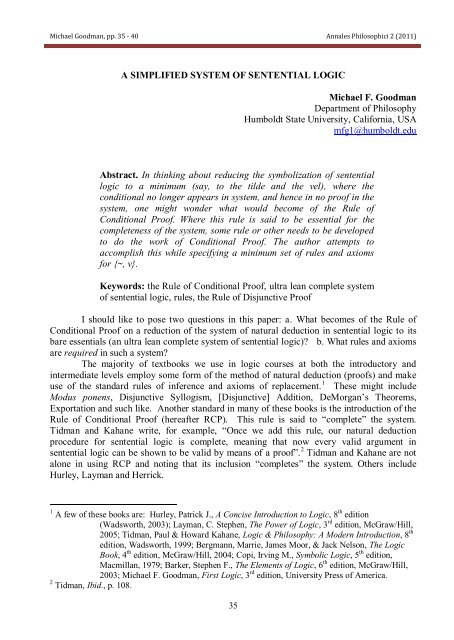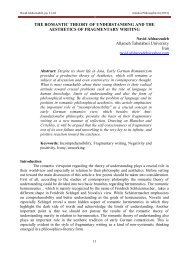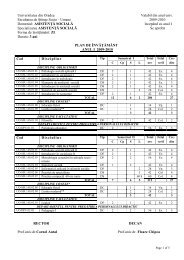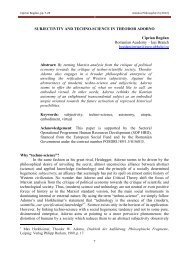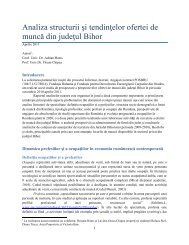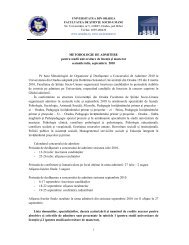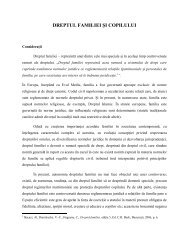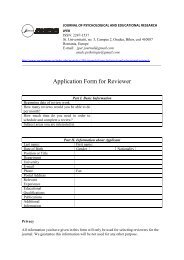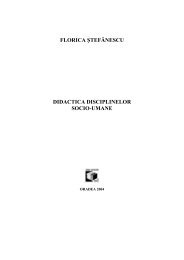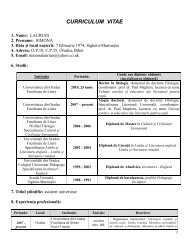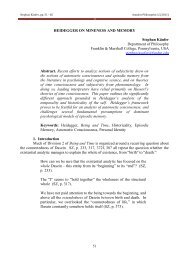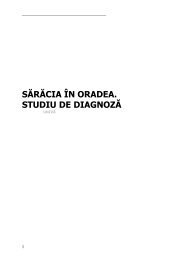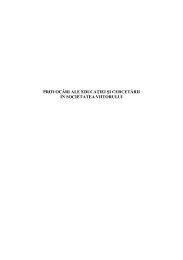Michael Goodman: A SIMPLIFIED SYSTEM OF SENTENTIAL LOGIC
Michael Goodman: A SIMPLIFIED SYSTEM OF SENTENTIAL LOGIC
Michael Goodman: A SIMPLIFIED SYSTEM OF SENTENTIAL LOGIC
You also want an ePaper? Increase the reach of your titles
YUMPU automatically turns print PDFs into web optimized ePapers that Google loves.
<strong>Michael</strong> <strong>Goodman</strong>, pp. 35 - 40 Annales Philosophici 2 (2011)<br />
A <strong>SIMPLIFIED</strong> <strong>SYSTEM</strong> <strong>OF</strong> <strong>SENTENTIAL</strong> <strong>LOGIC</strong><br />
35<br />
<strong>Michael</strong> F. <strong>Goodman</strong><br />
Department of Philosophy<br />
Humboldt State University, California, USA<br />
mfg1@humboldt.edu<br />
Abstract. In thinking about reducing the symbolization of sentential<br />
logic to a minimum (say, to the tilde and the vel), where the<br />
conditional no longer appears in system, and hence in no proof in the<br />
system, one might wonder what would become of the Rule of<br />
Conditional Proof. Where this rule is said to be essential for the<br />
completeness of the system, some rule or other needs to be developed<br />
to do the work of Conditional Proof. The author attempts to<br />
accomplish this while specifying a minimum set of rules and axioms<br />
for {~, v}.<br />
Keywords: the Rule of Conditional Proof, ultra lean complete system<br />
of sentential logic, rules, the Rule of Disjunctive Proof<br />
I should like to pose two questions in this paper: a. What becomes of the Rule of<br />
Conditional Proof on a reduction of the system of natural deduction in sentential logic to its<br />
bare essentials (an ultra lean complete system of sentential logic)? b. What rules and axioms<br />
are required in such a system?<br />
The majority of textbooks we use in logic courses at both the introductory and<br />
intermediate levels employ some form of the method of natural deduction (proofs) and make<br />
use of the standard rules of inference and axioms of replacement. 1 These might include<br />
Modus ponens, Disjunctive Syllogism, [Disjunctive] Addition, DeMorgan‘s Theorems,<br />
Exportation and such like. Another standard in many of these books is the introduction of the<br />
Rule of Conditional Proof (hereafter RCP). This rule is said to ―complete‖ the system.<br />
Tidman and Kahane write, for example, ―Once we add this rule, our natural deduction<br />
procedure for sentential logic is complete, meaning that now every valid argument in<br />
sentential logic can be shown to be valid by means of a proof‖. 2 Tidman and Kahane are not<br />
alone in using RCP and noting that its inclusion ―completes‖ the system. Others include<br />
Hurley, Layman and Herrick.<br />
1 A few of these books are: Hurley, Patrick J., A Concise Introduction to Logic, 8 th edition<br />
(Wadsworth, 2003); Layman, C. Stephen, The Power of Logic, 3 rd edition, McGraw/Hill,<br />
2005; Tidman, Paul & Howard Kahane, Logic & Philosophy: A Modern Introduction, 8 th<br />
edition, Wadsworth, 1999; Bergmann, Marrie, James Moor, & Jack Nelson, The Logic<br />
Book, 4 th edition, McGraw/Hill, 2004; Copi, Irving M., Symbolic Logic, 5 th edition,<br />
Macmillan, 1979; Barker, Stephen F., The Elements of Logic, 6 th edition, McGraw/Hill,<br />
2003; <strong>Michael</strong> F. <strong>Goodman</strong>, First Logic, 3 rd edition, University Press of America.<br />
2 Tidman, Ibid., p. 108.
Annales Philosophici 2 (2011) <strong>Michael</strong> <strong>Goodman</strong>, pp. 35 - 40<br />
Let us define RCP as follows: From any assumption,, closure of the scope of the<br />
assumption is accomplished by deriving , at which point is derived. is a formula<br />
derived either from the premises, and whatever assumption is open, or from other derived<br />
formulae in the proof. 3 A simple example of the use of RCP is as follows: 4<br />
1. [(S & J) C]<br />
2. (J v ~S) // (S C)<br />
3. S (Assumption)<br />
4. (~S v J) 2, Commutation<br />
5. J 3, 4 Disjunctive Syllogism<br />
6. (S & J) 3, 5 Conjunction<br />
7. C 1, 6 Modus Ponens<br />
8. (S C) 3-7, RCP<br />
Unlike RCP, there are rules that are unnecessary in the system. For instance, we can<br />
safely delete Modus tollens in favor of Material Implication and Disjunctive Syllogism. We<br />
can also omit one of the axioms of Association, namely<br />
[p & (q & r)] [(p & q) & r],<br />
in favor of Simplification, Commutation and Conjunction. 5<br />
Not only may certain rules/axioms be deleted without altering the completeness of the<br />
system, if one dislikes the overpopulation of distinct symbols themselves, these may be<br />
reduced by three. W.V.O. Quine, for example, shows that such reductions are possible in<br />
Mathematical Logic. 6 We know that {~, v} is functionally complete, as is {~, &}. 7 Below is<br />
a list of common rules and axioms which have been ―transformed‖ using only the tilde<br />
(negation) and the vel (disjunction). The common name is given for each rule/axiom.<br />
Modus ponens: (~p v q) p // q<br />
3 Benson Mates‘ use of Rule of Conditional Proof in his Elementary Logic is very tasty. He calls the<br />
rule Conditionalization and writes, ―The sentence () may be entered on a line if <br />
appears on an earlier line;...‖ (p. 112) and ―In its principle use, rule C says that if you<br />
have succeeded in obtaining from premises that include the sentence , then you may<br />
infer () and drop from your list of premises.‖ (p. 115) Mates‘ rule does not have<br />
the exact form of RCP because it does not specify that an assumption is made, but the<br />
essential aspect of deriving a conditional is the same.<br />
4 Key to symbols: &= for conjunction; = for material conditional; v= for disjunction; ~= for<br />
negation; < - >= for logical equivalence, //= as the conclusion indicator. /// is used in the<br />
lean system for logical equivalence.<br />
5 One may also drop Disjunctive Syllogism in favor of Double Negation, Material Implication and<br />
Modus ponens. To keep Modus tollens out, if Disjunctive Syllogism were dropped, one<br />
could use Transposition and Modus ponens. Some of the accepted rules amount to<br />
nothing more than short-cuts for use within a proof procedure.<br />
6 Quine, W.V.O., Mathematical Logic (New York: Norton, 1940).<br />
7 A very interesting and succinct bit on functional completeness appears in Gerald Massey‘s<br />
Understanding Symbolic Logic, New York: Harper & Row, 1970, ch. 13. Also of<br />
interest may be John Nolt‘s Logics, Belmont, CA: Wadsworth, 1997. Whereas Massey<br />
uses truth tables as the vehicle for showing completeness, Nolt uses the truth tree method.<br />
If the trees are considered as founded on, and justified by, the tables, the reduction<br />
appears obvious.<br />
36
<strong>Michael</strong> <strong>Goodman</strong>, pp. 35 - 40 Annales Philosophici 2 (2011)<br />
[Equiv to Disjunctive Syllogism]<br />
Modus tollens: (~p v q) ~q // ~p<br />
[Equiv to Disjunctive Syllogism]<br />
Disjunctive Syllogism: (p v q) ~p // q<br />
[Unchanged]<br />
[Disjunctive] Addition: p // (p v q)<br />
[Unchanged]<br />
Conjunction: p q // ~(~p v ~q)<br />
Hypothetical Syllogism: (~p v q) (~q v r) // (~p v r)<br />
Simplification: ~(~p v ~q) // p<br />
[Redundant to Tautology b.]<br />
Constructive Dilemma: ~[~(~p v q) v ~(~r v s)] (p v r) // (q v s)<br />
DeMorgan‘s Theorems: a. (~p v ~q) /// (~p v ~q)<br />
[Self-Redundant]<br />
b. ~(p v q) /// ~(p v q)<br />
[Self-Redundant]<br />
Commutation: a. (p v q) /// (q v p)<br />
[Unchanged]<br />
b. ~(~p v ~q) /// ~(~q v ~p)<br />
[Redundant to Commutation a.]<br />
Association: a. [p v (q v r)] /// [(p v q) v r]<br />
[Unchanged]<br />
b. ~[~p v (~q v ~r)] /// ~[(~p v ~q ) v ~r]<br />
[Redundant to Association a.]<br />
Distribution: a. ~[~p v ~(q v r)] /// [~(~p v ~q) v ~(~p v ~r)]<br />
Double Negation: p /// ~ ~p<br />
[Unchanged]<br />
b. [p v ~(~q v ~r)] /// ~[~(p v q) v ~(p v r)]<br />
Material Implication: (~p v q) /// (~p v q)<br />
[Self-Redundant]<br />
37
Annales Philosophici 2 (2011) <strong>Michael</strong> <strong>Goodman</strong>, pp. 35 - 40<br />
Transposition: (~p v q) /// (q v ~p)<br />
[Equiv to Commutation]<br />
Exportation: [(~p v ~q) v r] /// [~p v (~q v r)]<br />
Tautology: a. p /// (p v p)<br />
[Unchanged]<br />
b. p /// ~(~p v ~p)<br />
Without further ado, let us ask what becomes of the Rule of Conditional Proof within<br />
this system? If we drop the conditional sentence in favor of the disjunction (with the first<br />
disjunct negated), there will be no place for line #8 in the proof above. It is not as though we<br />
can just leave line #8 as it is and use Material Implication to get to (~S v C),in line #8,<br />
because Material Implication will have been excluded as unnecessary (since there will be no<br />
conditionals to turn into, or replace, disjunctions). For all that, we would not desire to exclude<br />
RCP from the system, of course, for it is a complete-making rule. So, perhaps there is a way to<br />
save it in some form. One suggestion may be that we opt for a proof procedure that uses<br />
reductio ad absurdum (Indirect Proof, as it is called by some logicians). This is a nonstarter,<br />
however, for reductio proofs themselves rely on RCP. The reason I say this is that, while<br />
many logicians countenance going from<br />
& ~<br />
to<br />
,<br />
a) we won‘t have conjunctions in the system, and b) this move hides the fact that knowing that<br />
everything follows from a contradiction is not the same as showing how, in fact, this is true<br />
(that is, how to show/prove it). However, showing that anything follows from a contradiction<br />
using a reductio proof requires assuming the negation of the conclusion of the argument,<br />
deriving a contradiction, deriving the conclusion itself on a line within the scope of the<br />
assumption, then closing the scope of the assumption, deriving a conditional. What one gets,<br />
then, is a conditional that is subsequently turned into a disjunction via Material Implication. A<br />
simple example of this, using a conditional (line #14) in the proof for convenience, is:<br />
1. (L v ~S)<br />
2. (~L v D) // (~S v D)<br />
3. ~(~S v D) Assumption, Denial of Conclusion<br />
4. (~ ~S & ~D) 3, DeMorgan's<br />
5. (S & ~D) 4, Double Negation<br />
6. (D v ~L) 2, Commutation<br />
7. ~D 5, Commutation, Simplification<br />
8. ~L 6,7 Disjunctive Syllogism<br />
9. (~S v L) 1, Commutation<br />
10. S 5, Simplification<br />
11. L 9,10 Disjunctive Syllogism<br />
12. [L v (~S v D)] 11, Disjunctive Addition<br />
13. (~S v D) 8,12 Disjunctive Syllogism<br />
38
<strong>Michael</strong> <strong>Goodman</strong>, pp. 35 - 40 Annales Philosophici 2 (2011)<br />
14. ~(~S v D) (~S v D) 3-13, Rule of Conditional Proof<br />
15. ~ ~(~S v D) v (~S v D) 14, Material Implication<br />
16. (~S v D) v (~S v D) 15, Double Negation<br />
17. (~S v D) 16, Tautology<br />
If one were to allow the following move, it would hide the conditional on line #14.<br />
12a. (L & ~L) 8,11 Conjunction<br />
13a. (~S v D) 3-12a Reductio ad Absurdum<br />
However, just because the conditional does not appear in the proof does not mean that<br />
it is not there tacitly. What 12a and 13a constitute is a short-cut Reductio, or, what is perhaps<br />
a better way of saying it, using Reductio ad absurdum as a rule rather than a method. 8 Lines<br />
12-17 use Reductio as a method.<br />
It is also important that ‗12a‘ above is a conjunction and conjunctions, in the form of<br />
‗‗ will not be allowed in the system where the only logical symbols will be ‗~‘ and ‗v‘.<br />
What I would like to propose is that since conditionals will not be allowed within the<br />
―lean‖ system (and conjunctions either, for that matter, though they are included above for<br />
convenience), and given that a rule doing the work of RCP is required for a complete system,<br />
we adopt the following rule, call it Rule of Disjunctive Proof. From any assumption, ,<br />
closure of the scope of the assumption is accomplished by deriving , at which point ~ v<br />
is derived. A simple example is:<br />
1. (M v ~T)<br />
2. ~(~T v ~R) // (M v ~R)<br />
3. R Assumption<br />
4. T 2, Rule of Premise 9<br />
5. M 1,4 Disjunctive Syllogism<br />
6. (~R v M) 3-5, Rule of Disjunctive Proof (RDP)<br />
7. (M v ~R) 6, Commutation.<br />
If each rule and axiom that is either redundant or reductive to some other rule or<br />
axiom is deleted from the system, and if we include Rule of Disjunctive Proof, we end up with<br />
the following rules and axioms for a complete system of sentential logic:<br />
Disjunctive Syllogism: (p v q) ~p // q<br />
Disjunctive Addition: p // (p v q)<br />
Disjunctive Negation: p q // ~(~p v ~q)<br />
8 I am not arguing that one should use Reductio ad absurdum as a method rather than a rule. Both are<br />
legitimate and can have their place within the proof procedure. Tidman & Kahane use<br />
the Reductio as a rule, as do Bergmann, Moore & Nelson, Hurley, Herrick, Layman and<br />
Copi (op cit.). Mates, on the other hand, seems to use it as a method (op cit. p. 119f).<br />
9 The concept of a ―Rule of Premise‖ comes from the late Herbert Hendry who used this wording to<br />
indicate that the inference is valid without specifying the exact set of rules/axioms used in<br />
deriving the formula. In the present case, in the non-lean system, the rules would be<br />
DeMorgan‘s, Simplification and Double Negation. Mates calls this Tautological<br />
inference, op. cit. p. 112. The deduction in this proof from line 2 to line 4 would be<br />
accomplished by the following rules: DeMorgan‘s, Double Negation, Simplification.<br />
39
Annales Philosophici 2 (2011) <strong>Michael</strong> <strong>Goodman</strong>, pp. 35 - 40<br />
Disjunctive Chain: (~p v q) (~q v r) // (~p v r)<br />
Constructive Dilemma: ~[~(~p v q) v ~(~r v s)] (p v r) // (q v s)<br />
Commutation: (p v q) /// (q v p)<br />
Association: [p v (q v r)] /// [(p v q) v r]<br />
Distribution: a. ~[~p v ~(q v r)] /// [~(~p v ~q) v ~(~p v ~r)]<br />
b. [p v ~(~q v ~r)] /// ~[~(p v q) v ~(p v r)]<br />
Double Negation: p /// ~ ~p<br />
Tautology: a. p /// (p v p)<br />
b. p /// ~(~p v ~p)<br />
Rule of Disjunctive Proof: Assume p, derive q, infer (~p v q)<br />
Use of the individual rules/axioms becomes an exercise in specification, almost busywork.<br />
However, if one admits the Rule of Premise (or Mates‘ Conditionalization rule),<br />
specifying any rules whatever seems almost arbitrary. That is, since Rule of Premise would<br />
take the place of a Disjunctive Addition move, or a Disjunctive Chain move, or a<br />
Commutation, it would also take the place of the use of these three at one time, as so: from<br />
―(Li v ~Ji)‖ and ―(~Li v Ki)‖, we could derive ―[(Ki v ~Ji) v Ji]‖.<br />
As a teaching tool, it could be argued that the set of rules under {~,v} would be very<br />
unintuitive as compared with the rules under {~, v, , < - > , &}, not to mention downright<br />
tedious. As a system, {~,v} seems far superior to {~, v, , < - > , &} for its simplicity as<br />
well as elegance.<br />
40


